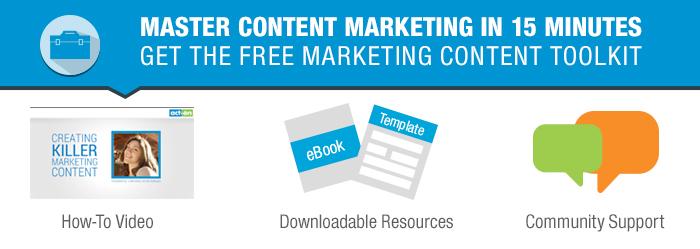Reuse. Recycle. Repurpose. In content marketing, these are the three “R’s” that come up with clockwork regularity. And for good reason:
They’re worth repeating.
Just as some books are worth reading more than once, so too are some topics; you often come away with new insights that might have been missed the first time through.
In this case, the topic is content repurposing – which is used interchangeably with the other two “R’s”. (It’s also known by a non-R term: content extensibility.) Whatever you call it, the net-net is this: you expand your content portfolio by taking what is already created or in plan, and recreating it in a different format.
Jim Burns, founder of content consultancy Avitage, refers to this concept as “having conversations through content.” It’s a wonderful description because it succinctly conveys the what, how, and why of content repurposing. Notice that they all stem from the same hub: conversations.
Drawing this line of thought a bit further, the meat and potatoes of content repurposing is about making the same conversations – the same content – accessible to audiences via different channels and formats. This means one piece of content can effectively become two, or seven, or even ten, giving you maximum mileage for your efforts.
Again, this is surely stuff you’ve read before. But we submit that it’s a topic worthy of occasional re-acquaintance for marketers. So let’s do it.
Benefits of repurposing your content
There are several advantages to repurposing. Here are four of the biggies:
Stress reduction. Though perhaps not the most strategic advantage, it’s often the most pressing. That’s because creating original content that covers all stages of the funnel, is valuable to your audience, and effective for sales and marketing efforts … and doing it day after day on tight deadlines … is a recipe for burnout.
Repurposing takes overwhelm down several notches by saving time and allowing for some breathing room (modifying existing content is a whole lot easier than creating something from scratch). This goes a long way to keeping content quality high and writer turnover low.
SEO love. Repurposing can give your SEO a welcome boost by increasing the number of pieces you have on the same topic and that target the same keyword.
Reach new audiences. By providing the same content in multiple formats (e.g., a blog post, an eBook, and an infographic), you can get it into the hands of more people and expand brand visibility.
Reinforce your message. Delivering your message in several formats and across multiple channels gives you the opportunity to repeat and reinforce your messages. This can increase your impact and open doors to continued conversations.
15 things you can do to jumpstart your content repurposing
What follows is a bit of a mixed bag to help spur your creativity and strategy, and ultimately make content repurposing work for you. They’re numbered sequentially for easy reading, but they aren’t in any particular order. Take what you like and leave the rest.
BEST PRACTICES
1. Plan content with the intent to reuse it. Content repurposing shouldn’t be an afterthought. Yes, there are and will be occasions when you’ll look at a piece of content and say, “Hey, we could turn this asset into lots of other great stuff.” But as a best practice, you should plan your content upfront with the intent for reusing it in multiple places. For example:
- If you have a video or a podcast, transcribe it and then pull out snippets that can be turned into reusable assets such as blog posts, polls/surveys, a checklist, or an eBook.
- If you have a juicy bottom-of-funnel eBook, simplify it into a top-of-funnel “intrigue” piece that delivers the salient points at a high level and can be used to generate leads.
- Jim Burns recommends creating an interview guide before interviewing a subject matter expert (SME), and creating it with content repurposing in mind. By doing so, you’ll not only know what you’re interviewing for in the short-term, you’ll end up with a more robust set of notes that you can then use to create additional content in other formats. For example, a white paper and a Q&A post.
2. Identify your evergreen content. Evergreen content is information that stays fresh and never goes out of date … or at least lasts a long time. (Think of evergreen trees or that soaring last note held by Barbra Streisand in the song “Evergreen” – she held that for 20 seconds.) As a rule of thumb, the best evergreen content addresses specific problems and solutions, rather than product features and capabilities. By identifying your top evergreen content, you can leverage it with the assurance that it won’t get outdated too quickly and will, therefore, produce returns many months or even years.
3. Scale content across as many channels and platforms as possible. Experts are all over the yard when it comes to declaring how many ways your content should be sliced and diced; I’ve seen the recommendations span between 3 and 30. But the spirit of this best practice is the same regardless of how many assets you can squeeze out of a single piece of content: extend your content so that it’s found by the most people.
For example, you have a webinar, turn it into a white paper, make it into a few blog posts, and socialize at every step.
4. Create new content by cherry-picking from existing content. Or at least restructuring existing pieces into one or more new assets. For example:
- Combine text from an older (evergreen!) whitepaper with new videos to create a multimedia eBook.
- Compile several blog posts on a related topic and turn them into a comprehensive eBook or white paper.
- Use a sales brochure or datasheet to create a new video.
- Distill a robust white paper or series of smaller, related articles into a 1- or 2-page “cheat sheet” reference.
- Turn videos into blog posts and eBooks. Each video can be the basis for a new blog post that includes a call-to-action link to the video and/or the eBook. Gate them with forms for lead generation.
- Use webinar questions and comments to create a new eBook or survey or poll. Compile the most interesting or commonly asked questions, have SMEs answer them, and create a Q&A piece that directly addresses your audience’s interests and pain points.
5. Cross-promote! This happens after you have a nice bank of repurposed content, but it’s key to extending your visibility and getting full benefit from your hard work. Cross-pollinate your content by weaving different formats and options into other formats and options. For example, link to videos from within your blog posts, add an eBook link as the call-to-action in an infographic, or incorporate a “you also might be interested in” sidebar on key website pages that take visitors to complementary content. Cross-promoting makes it easier to get found by more people, and it also can increase the stickiness of your site.
CONTENT IDEAS
Here are some asset types to consider when creating a repurposing plan.
6. Blog posts. Blogs are a great way to break down lengthy or complex pieces. Using a white paper as an example, you could break it into multiple posts that present easy-to-grok concepts from the larger paper. Link to the white paper as the call-to-action.
7. How-to videos. If your audience doesn’t have time to read and/or you want to present a topic that’s best served by “showing”, how-to videos fit the bill. Often they can be created at no or low cost because they can be done in-house using simple software and a video camera. Distribute them on your website, use in lead-generation campaigns, and be sure to post on YouTube, Vimeo, and other relevant sites that complement your business offering.
8. Animated video. Have a great webinar with a slide deck (or maybe just a great standalone slideshow)? Turn it into an animated video using a screen recorder (PowerPoint has one built in), overlay some royalty-free music, and post it on your website and other video channels.
9. Podcasts. Though not the biggest player, podcasts can be quite valuable to audiences that prefer to listen while driving or exercising, for example. Experiment by posting how-to conversations or Q&A interviews in podcast form on your website. If there is traction, you may consider expanding into iTunes.
10. Infographics. For people who don’t have the time or inclination to read dense copy, infographics can be highly successful in relaying information quickly, and in an engaging format that’s visually appealing. They’re also frequently picked up by online content syndicators, as well as shared across social media channels. (A twist on this is the instructographic, which focuses on how-to information. Pinterest has a great page that illustrates this idea.)
11. eBooks. The beauty of the eBook is that it’s a deep dive into a topic while also a relatively quick read. This accessibility is intentional: eBooks are created to be highly usable across the board: the information, the imagery, the layout, the flow. They can be written for any stage of the sales funnel and, as such, make great calls-to-action, particularly if they’re gated and capture lead-gen information.
12. Short briefs. This isn’t a specific content type, per se. Rather, it’s a catchall for those 1- and 2-page references that can generate a lot of traffic. Examples include cheat sheets, checklists, reference guides, and best-of lists. Create these by taking high-conversion pieces and pulling out the salient points. Be sure to include ways to share them.
13. Press releases. Reporters and publishers are constantly under pressure to find stories; the easier they are to find, the better. Press releases let you deliver. Though not optimal for every type of content, assets such as new case studies or research results can be repurposed into press releases. It’s a low/no-cost way to get coverage in multiple formats, including trade journals, magazines, blogs, podcasts, and other publications that cover your industry.
14. Social media. Social is an essential part of any marketing mix and can amplify your repurposing efforts. Use short phrases from your other content to create quick social media updates … teasers that link to your content and generate buzz. You can use social media schedulers to ensure your messages are going out regularly.
15. Images. Images deliver significant bang for the buck because they can be used everywhere: in email, websites, blog posts, social media (images are among the most shared items), eBooks, white papers, slideshows, videos, and reports, to name a few. From data displays to metaphors to icons to call-to-action touts, images offer spectacular versatility, both standalone and as part of larger content.
The fourth “R”
Final note: In addition to recycle, reuse, and repurpose, there’s another “R” that’s important for content marketers to keep in mind: Retire.
Even with the best evergreen content, there will come a time when it no longer delivers what it used to. And that’s ok. Just as repurposing your content can deliver immense value to your lead-gen efforts and save resource time, keeping assets that are beyond their sell-by date can undo some of that momentum. It’s important to keep your content valuable and relevant; older content can make you look like you’re not paying attention and are letting things stagnate.
It’s a balancing act. But as long as you keep the focus on adding value, your content repurposing efforts will stay fresh, engaging, and pay dividends.
Find out more with our free toolkit
Interested in more ways to create killer marketing content? Download our free toolkit.
“Boites à courier”, part of the Vitry Cultural Center Association of Arts, Vitry-sur-Seine, France.
“Barbra Streisand 1966”, Wikipedia
“Picking Cherries in Birkerød” by drmama, used under Creative Commons license



